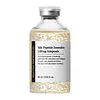What's inside
What's inside
 Key Ingredients
Key Ingredients

 Benefits
Benefits

 Concerns
Concerns

 Ingredients Side-by-side
Ingredients Side-by-side

Water
Skin ConditioningButylene Glycol
HumectantGlycerin
HumectantMethylpropanediol
Solvent1,2-Hexanediol
Skin ConditioningNiacinamide
SmoothingCarbomer
Emulsion StabilisingTromethamine
BufferingPPG-13-Decyltetradeceth-24
EmulsifyingHydroxyethylcellulose
Emulsion StabilisingSilk Extract
Skin ConditioningAdenosine
Skin ConditioningIron Powder
Agar
MaskingEthylhexylglycerin
Skin ConditioningDisodium EDTA
Acrylates/C10-30 Alkyl Acrylate Crosspolymer
Emulsion StabilisingSynthetic Fluorphlogopite
Betaine
HumectantPanthenol
Skin ConditioningHydrolyzed Elastin
EmollientTitanium Dioxide
Cosmetic ColorantCI 77491
Cosmetic ColorantMica
Cosmetic ColorantGellan Gum
Hydrolyzed Collagen
EmollientCentella Asiatica Extract
CleansingPropanediol
SolventMagnesium Ascorbyl Phosphate
AntioxidantPolygonum Fagopyrum Seed Extract
Skin ConditioningLecithin
EmollientAcetyl Glutamine
Skin ConditioningPhenoxyethanol
PreservativeArtemisia Vulgaris Extract
Skin ConditioningSodium Hyaluronate
HumectantCaprylyl Glycol
EmollientTin Oxide
AbrasiveGold
Cosmetic ColorantSqualane
EmollientHydrogenated Polyisobutene
EmollientBenzyl Glycol
SolventSh-Oligopeptide-1
Skin ConditioningSh-Polypeptide-1
Skin ConditioningSh-Oligopeptide-2
Skin ConditioningSh-Polypeptide-11
Sh-Polypeptide-9
Skin ConditioningBacillus
Skin ConditioningHydrolyzed Glycosaminoglycans
HumectantCollagen
MoisturisingTocopherol
AntioxidantSodium Hyaluronate Crosspolymer
HumectantCaffeoyl Hexapeptide-65
AntimicrobialHydrolyzed Hyaluronic Acid
HumectantSh-Decapeptide-7
AntioxidantSh-Octapeptide-4
AntioxidantSh-Oligopeptide-9
HumectantSh-Pentapeptide-19
Skin ConditioningHydroxypropyltrimonium Hyaluronate
Palmitoyl Pentapeptide-4
Skin ConditioningAcetyl Hexapeptide-8
HumectantCopper Tripeptide-1
Skin ConditioningHyaluronic Acid
HumectantUlmus Davidiana Root Extract
Skin ConditioningSodium Acetylated Hyaluronate
HumectantWater, Butylene Glycol, Glycerin, Methylpropanediol, 1,2-Hexanediol, Niacinamide, Carbomer, Tromethamine, PPG-13-Decyltetradeceth-24, Hydroxyethylcellulose, Silk Extract, Adenosine, Iron Powder, Agar, Ethylhexylglycerin, Disodium EDTA, Acrylates/C10-30 Alkyl Acrylate Crosspolymer, Synthetic Fluorphlogopite, Betaine, Panthenol, Hydrolyzed Elastin, Titanium Dioxide, CI 77491, Mica, Gellan Gum, Hydrolyzed Collagen, Centella Asiatica Extract, Propanediol, Magnesium Ascorbyl Phosphate, Polygonum Fagopyrum Seed Extract, Lecithin, Acetyl Glutamine, Phenoxyethanol, Artemisia Vulgaris Extract, Sodium Hyaluronate, Caprylyl Glycol, Tin Oxide, Gold, Squalane, Hydrogenated Polyisobutene, Benzyl Glycol, Sh-Oligopeptide-1, Sh-Polypeptide-1, Sh-Oligopeptide-2, Sh-Polypeptide-11, Sh-Polypeptide-9, Bacillus, Hydrolyzed Glycosaminoglycans, Collagen, Tocopherol, Sodium Hyaluronate Crosspolymer, Caffeoyl Hexapeptide-65, Hydrolyzed Hyaluronic Acid, Sh-Decapeptide-7, Sh-Octapeptide-4, Sh-Oligopeptide-9, Sh-Pentapeptide-19, Hydroxypropyltrimonium Hyaluronate, Palmitoyl Pentapeptide-4, Acetyl Hexapeptide-8, Copper Tripeptide-1, Hyaluronic Acid, Ulmus Davidiana Root Extract, Sodium Acetylated Hyaluronate
 Reviews
Reviews

Ingredients Explained
These ingredients are found in both products.
Ingredients higher up in an ingredient list are typically present in a larger amount.
Glycerin is already naturally found in your skin. It helps moisturize and protect your skin.
A study from 2016 found glycerin to be more effective as a humectant than AHAs and hyaluronic acid.
As a humectant, it helps the skin stay hydrated by pulling moisture to your skin. The low molecular weight of glycerin allows it to pull moisture into the deeper layers of your skin.
Hydrated skin improves your skin barrier; Your skin barrier helps protect against irritants and bacteria.
Glycerin has also been found to have antimicrobial and antiviral properties. Due to these properties, glycerin is often used in wound and burn treatments.
In cosmetics, glycerin is usually derived from plants such as soybean or palm. However, it can also be sourced from animals, such as tallow or animal fat.
This ingredient is organic, colorless, odorless, and non-toxic.
Glycerin is the name for this ingredient in American English. British English uses Glycerol/Glycerine.
Learn more about GlycerinPhenoxyethanol is a preservative that has germicide, antimicrobial, and aromatic properties. Studies show that phenoxyethanol can prevent microbial growth. By itself, it has a scent that is similar to that of a rose.
It's often used in formulations along with Caprylyl Glycol to preserve the shelf life of products.
sh-Oligopeptide-1 is a peptide found naturally in our bodies. Peptides are the building blocks for collagen and elastin in our skin.
In cosmetics, this ingredient is bioengineered to be identical to a human gene that codes for epidermal growth factor (EGF). EGF are signal molecules that simulate cell growth and healing.
Studies find EGF help with:
In South Korea and China, EGF is considered a controversial ingredient. The South Korean Ministry of Food and Drug Safety has cracked down on companies with products including EGF due to false advertisement claims.
According to Dr. Zoe Draelos, growth factors have some drawbacks:
There is also controversy surrounding growth factors. The controversy is due to their mitogenic activity, or their ability to increase the number of cells. It is best to avoid using growth factors if you have psoriasis or are at risk of skin cancer. However, it should be noted EGF are not mutagenic - meaning they will not cause cancer.
Learn more about Sh-Oligopeptide-1Sodium Hyaluronate is hyaluronic acid's salt form. It is commonly derived from the sodium salt of hyaluronic acid.
Like hyaluronic acid, it is great at holding water and acts as a humectant. This makes it a great skin hydrating ingredient.
Sodium Hyaluronate is naturally occurring in our bodies and is mostly found in eye fluid and joints.
These are some other common types of Hyaluronic Acid:
Learn more about Sodium HyaluronateWater. It's the most common cosmetic ingredient of all. You'll usually see it at the top of ingredient lists, meaning that it makes up the largest part of the product.
So why is it so popular? Water most often acts as a solvent - this means that it helps dissolve other ingredients into the formulation.
You'll also recognize water as that liquid we all need to stay alive. If you see this, drink a glass of water. Stay hydrated!
Learn more about Water